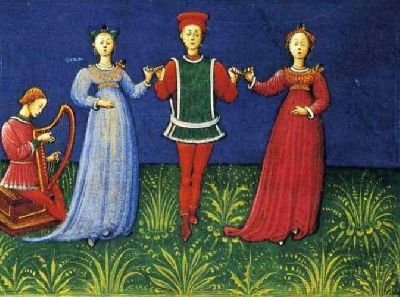Guglielmo Ebreo Da Pesaro on:
[Wikipedia]
[Google]
[Amazon]
 Guglielmo Ebreo da Pesaro (c. 1420 – c. 1484) was a Jewish Italian dancer and dancing master at some of the most influential courts in
Guglielmo Ebreo da Pesaro (c. 1420 – c. 1484) was a Jewish Italian dancer and dancing master at some of the most influential courts in
 Guglielmo Ebreo da Pesaro (c. 1420 – c. 1484) was a Jewish Italian dancer and dancing master at some of the most influential courts in
Guglielmo Ebreo da Pesaro (c. 1420 – c. 1484) was a Jewish Italian dancer and dancing master at some of the most influential courts in Renaissance Italy
The Italian Renaissance ( ) was a period in History of Italy, Italian history between the 14th and 16th centuries. The period is known for the initial development of the broader Renaissance culture that spread across Western Europe and marked t ...
, including Naples, Urbino
Urbino ( , ; Romagnol: ''Urbìn'') is a ''comune'' (municipality) in the Italy, Italian region of Marche, southwest of Pesaro, a World Heritage Site notable for a remarkable historical legacy of independent Renaissance culture, especially und ...
, Milan, and Ferrara. His byname '' Ebreo'' means simply ‘Hebrew
Hebrew (; ''ʿÎbrit'') is a Northwest Semitic languages, Northwest Semitic language within the Afroasiatic languages, Afroasiatic language family. A regional dialect of the Canaanite languages, it was natively spoken by the Israelites and ...
.’ Not always used when referring to him, ''da Pesaro'' indicates that he was from the east-central town of Pesaro
Pesaro (; ) is a (municipality) in the Italy, Italian region of Marche, capital of the province of Pesaro and Urbino, on the Adriatic Sea. According to the 2011 census, its population was 95,011, making it the second most populous city in the ...
. Between October 1463 and May 1465, Guglielmo probably converted from Judaism to Roman Catholicism and took the name Giovanni Ambrosio.
He studied with Domenico da Piacenza (sometimes known as Domenico da Ferrara) in the 1440s, and is mentioned in Domenico's ''Liber ballorum'' (1460).
Around 1463, Guglielmo authored the treatise ''De pratica seu arte tripudii'' (''On the Practice or Art of Dancing''), sometimes cited as ''Trattato dell' arte del ballare'' (''Treatise on the Art of Dancing''). In it, Guglielmo defends dancing as a noble art, emphasizing the important role of music. He also describes qualities necessary for dancers, including posture, musicality, style, and memory, and provides first-hand accounts of massive court celebrations in which he played a role. The treatise contains choreographies and music for thirty-six dances by Guglielmo and his contemporaries.
Conversion to Roman Catholicism
Between 1463 and 1465 Guglielmo was baptized and took the name of Giovanni Ambrogio. His patron and friendAlessandro Sforza
Alessandro Sforza (21 October 1409 – 3 April 1473) was an Italian condottiero and lord of Pesaro, the first of the Pesaro line of the Sforza family.
Biography
He was born in Cotignola in 1409, an illegitimate son of the famous condottier ...
(Lord of Pesaro and brother of Francesco Sforza) convinced Guglielmo to convert to Roman Catholicism
The Catholic Church (), also known as the Roman Catholic Church, is the List of Christian denominations by number of members, largest Christian church, with 1.27 to 1.41 billion baptized Catholics Catholic Church by country, worldwid ...
. Alessandro Sforza was a very religious man, but perhaps also influenced Guglielmo's ability to access the dignity of Knight.
In 1469 Guglielmo became a Knight of the Golden Spur, as had his teacher Domenico da Piacenza.
In honour of Alessandro Sforza's daughter, Ginevra, Guglielmo composed a '' bassadanza in due''. In 1465 he moved to Milan
Milan ( , , ; ) is a city in northern Italy, regional capital of Lombardy, the largest city in Italy by urban area and the List of cities in Italy, second-most-populous city proper in Italy after Rome. The city proper has a population of nea ...
, where he was in charge of the celebrations for the wedding of Eleonora d'Aragona with the Duke of Bari.
See also
*Italian folk dance
Italian folk dance has been an integral part of Italian culture for centuries. Dance has been a continuous thread in Italian life from Dante through the Renaissance, the advent of the tarantella in southern Italy, and the modern revivals of fol ...
References
External links
* {{DEFAULTSORT:Ebreo da Pesaro, Guglielmo Converts to Roman Catholicism from Judaism Renaissance dance 15th-century Italian Jews 15th-century Italian people Italian male dancers Italian Roman Catholics Year of birth uncertain 1480s deaths 15th-century dancers